Hospitalization Due to Fire-Induced Pollution in the Brazilian Legal Amazon from 2005 to 2018
Abstract
1. Introduction
2. Materials and Methods
2.1. Study Area
2.2. Data
2.2.1. Instrumental Variable Data
2.2.2. Explanatory Variable
2.2.3. Dependent Variables
2.2.4. Control Variables
2.3. Spatial Aggregation
2.4. Empirical Analysis
- Healthcare supply capacity, represented by the number of health professionals (Emp), number of hospital beds (Beds), and number of health facilities (Faci);
- Sociodemographic factors, such as estimated population (Pop), gross domestic product (GDP), urban zones (Urb), road density (Road), and fleet of cars (Cars);
- Weather, indicated here by the temperature (Temp) and rainfall (Precp).
- Generalized Hausman test for the null of consistency of the random-effects estimator (no omitted heterogeneity bias) against the alternative of consistency of the fixed-effects estimator only. Here, the “xtoverid” command developed by Schaffer and Stillman [63] was applied;
- Pollution exogeneity test for the null that ordinary least squares (OLS) would yield consistent estimates over the IV estimates, i.e., pollution is exogenous. For this, the “dmexogxt” command from Baum and Stillman [64] was applied;
- Sargan’s overidentification test for instrument validity which assumes validity under the null hypothesis that all instruments are valid, while rejection is interpreted as indicating that at least one of the instruments is not valid [65]. For this, the “xtoverid” command from Schaffer and Stillman [63] was used;
- Tests for instrument weakness in the first stage, which were based on post-estimation procedures with robust covariance matrix:
- Stock and Yogo’s IV weakness test, which presumes homoscedastic errors in the instruments, and its null hypothesis is that the instrument is weak. This is rejected whenever the “minimum eigenvalue statistic” [65] exceeds the “critical value” at a 10% level.
2.5. Simulation: Hospitalizations Attributable to Fires
3. Results
3.1. Data Description
3.2. Econometrics Estimates
3.3. Hospitalization Attributable to Fires
3.4. Robustness Check
4. Discussion
5. Conclusions
Supplementary Materials
Author Contributions
Funding
Institutional Review Board Statement
Informed Consent Statement
Acknowledgments
Conflicts of Interest
References
- Cassou, E. Agricultural Pollution: Field Burning; World Bank: Washington, DC, USA, 2018. [Google Scholar]
- Watts, J.D.; Tacconi, L.; Hapsari, N.; Irawan, S.; Sloan, S.; Widiastomo, T. Incentivizing compliance: Evaluating the effectiveness of targeted village incentives for reducing burning in Indonesia. For. Policy Econ. 2019, 108, 101956. [Google Scholar] [CrossRef]
- Carmo, C.N.D.; Alves, M.B.; Hacon, S.D.S. Impact of biomass burning and weather conditions on children’s health in a city of Western Amazon region. Air Qual. Atmos. Health 2013, 6, 517–525. [Google Scholar] [CrossRef]
- Arbex, M.A.; Martins, L.C.; de Oliveira, R.C.; Pereira, L.A.A.; Arbex, F.F.; Cançado, J.E.D.; Saldiva, P.H.N.; Braga, A.L.F. Air pollution from biomass burning and asthma hospital admissions in a sugar cane plantation area in Brazil. J. Epidemiol. Community Health 2007, 61, 395–400. [Google Scholar] [CrossRef]
- Kumar, P.; Kumar, S.; Joshi, L. Valuation of the Health Effects. In Perspectives on Social LCA; Springer: Singapore, 2015; pp. 35–67. [Google Scholar]
- Chagas, A.L.; Azzoni, C.R.; Almeida, A.N. A spatial difference-in-differences analysis of the impact of sugarcane production on respiratory diseases. Reg. Sci. Urban. Econ. 2016, 59, 24–36. [Google Scholar] [CrossRef]
- Sheldon, T.L.; Sankaran, C. The Impact of Indonesian Forest Fires on Singaporean Pollution and Health. Am. Econ. Rev. 2017, 107, 526–529. [Google Scholar] [CrossRef] [PubMed]
- Reddington, C.; Butt, E.W.; Ridley, D.A.; Artaxo, P.; Morgan, W.T.; Coe, H.; Spracklen, D.V. Air quality and human health improvements from reductions in deforestation-related fire in Brazil. Nat. Geosci. 2015, 8, 768–771. [Google Scholar] [CrossRef]
- INPE Monitoramento Dos Focos Ativos Por Estado/Região/Bioma. Available online: http://www.inpe.br/queimadas/portal/estatistica_estados (accessed on 26 November 2020).
- Alencar, A.; Rodrigues, L.; Castro, I. Amazônia em Chamas: O Que Queima e Onde; Instituto de Pesquisa Ambiental da Amazônia: Brasilia, Brazil, 2020. [Google Scholar]
- Aragão, L.E.O.C.; Malhi, Y.; Roman-Cuesta, R.M.; Saatchi, S.; Anderson, L.; Shimabukuro, Y.E. Spatial patterns and fire response of recent Amazonian droughts. Geophys. Res. Lett. 2007, 34, 07701. [Google Scholar] [CrossRef]
- Aragão, L.E.O.C.; Anderson, L.O.; Fonseca, M.G.; Rosan, T.M.; Vedovato, L.B.; Wagner, F.H.; Silva, C.V.J.; Junior, C.H.L.S.; Arai, E.; Aguiar, A.P.; et al. 21st Century drought-related fires counteract the decline of Amazon deforestation carbon emissions. Nat. Commun. 2018, 9, 536. [Google Scholar] [CrossRef]
- Reisen, F.; Duran, S.M.; Flannigan, M.; Elliott, C.; Rideout, K. Wildfire smoke and public health risk. Int. J. Wildland Fire 2015, 24, 1029. [Google Scholar] [CrossRef]
- Permentier, K.; Vercammen, S.; Soetaert, S.; Schellemans, C. Carbon dioxide poisoning: A literature review of an often forgotten cause of intoxication in the emergency department. Int. J. Emerg. Med. 2017, 10, 14. [Google Scholar] [CrossRef]
- Wooldridge, J.M. Introductory Econometrics: A Modern Approach, 7th ed.; Cengage Learning South-Western: Cincinnati, OH, USA, 2020; ISBN 9781337558860. [Google Scholar]
- Deryugina, T.; Heutel, G.; Miller, N.H.; Molitor, D.; Reif, J. The Mortality and Medical Costs of Air Pollution: Evidence from Changes in Wind Direction. Am. Econ. Rev. 2019, 109, 4178–4219. [Google Scholar] [CrossRef]
- He, G.; Liu, T.; Zhou, M. Straw burning, PM2.5, and death: Evidence from China. J. Dev. Econ. 2020, 145, 102468. [Google Scholar] [CrossRef]
- Gonçalves, K.D.S.; Winkler, M.S.; Benchimol-Barbosa, P.R.; de Hoogh, K.; Artaxo, P.E.; Hacon, S.D.S.; Schindler, C.; Künzli, N. Development of non-linear models predicting daily fine particle concentrations using aerosol optical depth retrievals and ground-based measurements at a municipality in the Brazilian Amazon region. Atmos. Environ. 2018, 184, 156–165. [Google Scholar] [CrossRef]
- Smith, L.; Aragão, L.E.O.C.; Sabel, C.; Nakaya, T. Drought impacts on children’s respiratory health in the Brazilian Amazon. Sci. Rep. 2015, 4, 3726. [Google Scholar] [CrossRef] [PubMed]
- Machado-Silva, F.; Libonati, R.; de Lima, T.F.M.; Peixoto, R.; França, J.R.D.A.; Magalhães, M.D.A.F.M.; Santos, F.L.M.; Rodrigues, J.A.; DaCamara, C.C. Drought and fires influence the respiratory diseases hospitalizations in the Amazon. Ecol. Indic. 2020, 109, 105817. [Google Scholar] [CrossRef]
- de Mendonça, M.J.C.; Diaz, M.D.C.V.; Nepstad, D.; da Motta, R.S.; Alencar, A.; Gomes, J.C.; Ortiz, R.A. The economic cost of the use of fire in the Amazon. Ecol. Econ. 2004, 49, 89–105. [Google Scholar] [CrossRef]
- Do Carmo, C.N.; Hacon, S.; Longo, K.M.; Freitas, S.; Ignotti, E.; de Leon, A.P.; Artaxo, P. Associação Entre Material Particulado de Queimadas e Doenças Respiratórias Na Região Sul Da Amazônia Brasileira. Rev. Panam. De Salud Publica 2010, 27, 10–16. [Google Scholar] [CrossRef]
- Jacobson, L.D.S.V.; Hacon, S.D.S.; De Castro, H.A.; Ignotti, E.; Artaxo, P.; Saldiva, P.H.N.; De Leon, A.C.M.P. Acute Effects of Particulate Matter and Black Carbon from Seasonal Fires on Peak Expiratory Flow of Schoolchildren in the Brazilian Amazon. PLoS ONE 2014, 9, e104177. [Google Scholar] [CrossRef] [PubMed]
- BRASIL. Institui, Na Forma Do Art. 43 Da Constituição Federal, a Superintendência Do Desenvolvimento Da Amazônia–SUDAM.; Estabelece Sua Composição, Natureza Jurídica, Objetivos, Área de Competência e Instrumentos de Ação; Dispõe Sobre o Fundo de Desenvolvimento Da Amazônia–FDA.; Altera a Medida Provisória No 2.157-5, de 24 de Agosto de 2001; Revoga a Lei Complementar No 67, de 13 de Junho de 1991; e Dá Outras Providências; Diário Oficial da União: Brasília, Brasil, 2007. [Google Scholar]
- IBGE. Amazônia Legal; IBGE-Instituto Brazileito de Geografia e Estatistica: Rio de Janeiro, RJ, Brazil, 2020. [Google Scholar]
- Aquino, R.; De Oliveira, N.F.; Barreto, M.L. Impact of the Family Health Program on Infant Mortality in Brazilian Municipalities. Am. J. Public Health 2009, 99, 87–93. [Google Scholar] [CrossRef]
- Harris, M.C.; Kohn, J.L. Reference Health and the Demand for Medical Care. Econ. J. 2018, 128, 2812–2842. [Google Scholar] [CrossRef]
- Busetto, L.; Ranghetti, L. MODIStsp: An R package for automatic preprocessing of MODIS Land Products time series. Comput. Geosci. 2016, 97, 40–48. [Google Scholar] [CrossRef]
- Giglio, L.; Justice, C.; Boschetti, L.; Roy, D. MCD64A1 MODIS/Terra+Aqua Burned Area Monthly L3 Global 500m SIN Grid V006 2015. Available online: https://lpdaac.usgs.gov/products/mcd64a1v006/ (accessed on 29 December 2020).
- Boschetti, L.; Roy, D.P.; Giglio, L.; Huang, H.; Zubkova, M.; Humber, M.L. Global validation of the collection 6 MODIS burned area product. Remote. Sens. Environ. 2019, 235, 111490. [Google Scholar] [CrossRef]
- Pessôa, A.; Anderson, L.; Carvalho, N.; Campanharo, W.; Junior, C.; Rosan, T.; Reis, J.; Pereira, F.; Assis, M.; Jacon, A.; et al. Intercomparison of Burned Area Products and Its Implication for Carbon Emission Estimations in the Amazon. Remote. Sens. 2020, 12, 3864. [Google Scholar] [CrossRef]
- INPE Banco de Dados de Queimadas. Available online: https://queimadas.dgi.inpe.br/queimadas/bdqueimadas (accessed on 10 May 2021).
- Giglio, L.; Justice, C. MYD14A1 MODIS/Aqua Thermal Anomalies/Fire Daily L3 Global 1km SIN Grid V006 2015. Available online: https://lpdaac.usgs.gov/products/myd14a1v006/ (accessed on 29 December 2020).
- Alonso-Canas, I.; Chuvieco, E. Global burned area mapping from ENVISAT-MERIS and MODIS active fire data. Remote. Sens. Environ. 2015, 163, 140–152. [Google Scholar] [CrossRef]
- Libonati, R.; da Camara, C.C.; Setzer, A.W.; Morelli, F.; de Jesus, S.C.; Candido, P.A.; Melchiori, A.E. Validation of the Burned Area “(V,W)” Modis Algorithm in Brazil. In Advances in Forest Fire Research; Imprensa da Universidade de Coimbra: Coimbra, Portugal, 2014; pp. 1774–1785. ISBN 978-989-26-0884-6. [Google Scholar]
- Copernicus Climate Change Service. ERA5 Monthly Averaged Data on Single Levels from 1979 to Present 2019. Available online: https://cds.climate.copernicus.eu/cdsapp#!/dataset/reanalysis-era5-single-levels-monthly-means?tab=overview (accessed on 29 December 2020).
- Fernández-López, J.; Schliep, K. rWind: Download, edit and include wind data in ecological and evolutionary analysis. Ecography 2019, 42, 804–810. [Google Scholar] [CrossRef]
- Lyapustin, A.; Wang, Y. MCD19A2 MODIS/Terra+Aqua Land Aerosol Optical Depth Daily L2G Global 1km SIN Grid V006 2018. Available online: https://lpdaac.usgs.gov/products/mcd19a2v006/ (accessed on 29 December 2020).
- Kumar, N. What Can Affect AOD–PM 2.5 Association? Environ. Health Perspect. 2010, 118, A109–A110. [Google Scholar] [CrossRef]
- Martins, V.S.; Lyapustin, A.; Carvalho, L.A.S.; Barbosa, C.C.F.; Novo, E.M.L.M. Validation of high-resolution MAIAC aerosol product over South America. J. Geophys. Res. Atmos. 2017, 122, 7537–7559. [Google Scholar] [CrossRef]
- Guo, J.; Xia, F.; Zhang, Y.; Liu, H.; Li, J.; Lou, M.; He, J.; Yan, Y.; Wang, F.; Min, M.; et al. Impact of diurnal variability and meteorological factors on the PM2.5-AOD relationship: Implications for PM2.5 remote sensing. Environ. Pollut. 2017, 221, 94–104. [Google Scholar] [CrossRef] [PubMed]
- Chudnovsky, A.; Tang, C.; Lyapustin, A.; Wang, Y.; Schwartz, J.; Koutrakis, P. A critical assessment of high-resolution aerosol optical depth retrievals for fine particulate matter predictions. Atmos. Chem. Phys. Discuss. 2013, 13, 10907–10917. [Google Scholar] [CrossRef]
- Alvim, D.; Chiquetto, J.; D’Amelio, M.; Khalid, B.; Herdies, D.; Pendharkar, J.; Corrêa, S.; Figueroa, S.; Frassoni, A.; Capistrano, V.; et al. Evaluating Carbon Monoxide and Aerosol Optical Depth Simulations from CAM-Chem Using Satellite Observations. Remote. Sens. 2021, 13, 2231. [Google Scholar] [CrossRef]
- Li, R.; Mei, X.; Chen, L.; Wang, L.; Wang, Z.; Jing, Y. Long-Term (2005–2017) View of Atmospheric Pollutants in Central China Using Multiple Satellite Observations. Remote. Sens. 2020, 12, 1041. [Google Scholar] [CrossRef]
- DataSUS Informações de Saúde (TABNET). Available online: http://www2.datasus.gov.br/DATASUS/index.php?area=02 (accessed on 28 December 2020).
- IBGE Produto Interno Bruto dos Municípios. Available online: https://www.ibge.gov.br/estatisticas/economicas/contas-nacionais/9088-produto-interno-bruto-dos-municipios.html (accessed on 23 March 2021).
- Malta, D.C.; De Moura, L.; Prado, R.R.D.; Escalante, J.C.; Schmidt, M.I.; Duncan, B.B. Mortalidade por doenças crônicas não transmissíveis no Brasil e suas regiões, 2000 a 2011. Epidemiol. E Serv. De Saude Rev. Do Sist. Unico De Saude Do Bras. 2014, 23, 599–608. [Google Scholar] [CrossRef]
- Wan, Z.; Hook, S.; Hulley, G. MOD11A2 MODIS/Terra Land Surface Temperature/Emissivity 8-Day L3 Global 1km SIN Grid V006 2015. Available online: https://lpdaac.usgs.gov/products/mcd19a2v006/ (accessed on 29 December 2020).
- Funk, C.; Peterson, P.; Landsfeld, M.; Pedreros, D.; Verdin, J.; Shukla, S.; Husak, G.; Rowland, J.; Harrison, L.; Hoell, A.; et al. The climate hazards infrared precipitation with stations—A new environmental record for monitoring extremes. Sci. Data 2015, 2, 150066. [Google Scholar] [CrossRef]
- Anderson, L.O.; Neto, G.R.; Cunha, A.P.; Fonseca, M.G.; De Moura, Y.M.; Dalagnol, R.; Wagner, F.H.; de Aragão, L.E. Vulnerability of Amazonian forests to repeated droughts. Philos. Trans. R. Soc. B Biol. Sci. 2018, 373, 20170411. [Google Scholar] [CrossRef]
- OSM Download OpenStreetMap Data for This Region: Brazil. Available online: https://download.geofabrik.de/south-america/brazil.html (accessed on 28 December 2020).
- MINFRA Estatísticas-Frota de Veículos–DENATRAN. Available online: https://www.gov.br/infraestrutura/pt-br/assuntos/transito/conteudo-denatran/estatisticas-frota-de-veiculos-denatran (accessed on 28 December 2020).
- Biomas Project—Collection 4.1. Annual Brazilian Land Use and Land Cover Maps. 2020. Available online: https://mapbiomas.org/ (accessed on 11 May 2020).
- Souza, C.M.; Shimbo, J.Z.; Rosa, M.R.; Parente, L.L.; Alencar, A.; Rudorff, B.F.; Hasenack, H.; Matsumoto, M.; Ferreira, L.G.; E Souza-Filho, P.W.; et al. Reconstructing Three Decades of Land Use and Land Cover Changes in Brazilian Biomes with Landsat Archive and Earth Engine. Remote Sens. 2020, 12, 2735. [Google Scholar] [CrossRef]
- Ignotti, E.; Valente, J.G.; Longo, K.M.; Freitas, S.R.; Hacon, S.D.S.; Netto, P.A. Impact on human health of particulate matter emitted from burnings in the Brazilian Amazon region. Rev. De Saúde Pública 2010, 44, 121–130. [Google Scholar] [CrossRef] [PubMed]
- Urbanski, S.P.; Hao, W.M.; Baker, S. Chapter 4 Chemical Composition of Wildland Fire Emissions. In Developments in Environmental Science; Elsevier: Amsterdam, The Netherlands, 2008; Volume 8, pp. 79–107. [Google Scholar]
- Bernard, S.M.; Samet, J.M.; Grambsch, A.; Ebi, K.L.; Romieu, I. The potential impacts of climate variability and change on air pollution-related health effects in the United States. Environ. Health Perspect. 2001, 109, 199–209. [Google Scholar] [CrossRef]
- Liu, Y.; Ao, C. Effect of air pollution on health care expenditure: Evidence from respiratory diseases. Health Econ. 2021, 30, 858–875. [Google Scholar] [CrossRef]
- Rocha, R.; Sant’Anna, A. Winds of Fire and Smoke: Air Pollution and Health in the Brazilian Amazon; IEPS, Instituto de Estudos para Políticas de Saúde: São Paulo, SP, Brazil, 2020. [Google Scholar]
- Barufi, A.M.; Haddad, E.A.; Paez, A. Infant mortality in Brazil, 1980-2000: A spatial panel data analysis. BMC Public Health 2012, 12, 181. [Google Scholar] [CrossRef] [PubMed]
- Pope, C.A. Epidemiology of fine particulate air pollution and human health: Biologic mechanisms and who’s at risk? Environ. Heal Perspect. 2000, 108, 713–723. [Google Scholar] [CrossRef]
- Nunes, K.V.R.; Ignotti, E.; Hacon, S.D.S. Circulatory disease mortality rates in the elderly and exposure to PM2.5 generated by biomass burning in the Brazilian Amazon in 2005. Cad. De Saúde Pública 2013, 29, 589–598. [Google Scholar] [CrossRef] [PubMed]
- Schaffer, M.E.; Stillman, S. XTOVERID: Stata Module to Calculate Tests of Overidentifying Restrictions after Xtreg, Xtivreg, Xtivreg2, Xthtaylor 2006. Available online: https://sociorepec.org/publication.xml?h=repec:boc:bocode:s456779&l=en (accessed on 26 October 2020).
- Baum, C.F.; Stillman, S. DMEXOGXT: Stata Module to Test Consistency of OLS vs XT-IV Estimate 1999. Available online: https://bia.unibz.it/esploro/outputs/code/DMEXOGXT-Stata-module-to-test-consistency/991005772344201241 (accessed on 26 October 2020).
- Cameron, A.C.; Trivedi, P.K. Microeconometrics Using STATA; STATA Press: College Station, TX, USA, 2009; ISBN 978-1-59718-048-1. [Google Scholar]
- Staiger, D.; Stock, J.H. Instrumental Variables Regression with Weak Instruments. Econometrica 1997, 65, 557. [Google Scholar] [CrossRef]
- Shao, H.; Stoecker, C.; Yang, S.; Shi, L. The pitfall of instrumental variables in big data: What the rule of thumb can’t give you. Commun. Stat.-Simul. Comput. 2019, 48, 2118–2124. [Google Scholar] [CrossRef]
- Giglio, L.; Schroeder, W.; Hall, J.V.; Justice, C.O. MODIS Collection 6 Active Fire Product User’s Guide (Revision c); University of Maryland: College Park, MD, USA, 2020. [Google Scholar]
- de Mendonça, M.J.C.; Sachsida, A.; Loureiro, P.R.A. Estimation of damage to human health due to forest burning in the Amazon. J. Popul. Econ. 2006, 19, 593–610. [Google Scholar] [CrossRef]
- Silva, P.R.S.; Rosa, A.M.; Hacon, S.S.; Ignotti, E. Hospitalization of children for asthma in the Brazilian Amazon: Trend and spatial distribution. J. De Pediatr. 2009, 85, 541–546. [Google Scholar] [CrossRef][Green Version]
- Filho, V.S.D.A.; Artaxo, P.; Hacon, S.; Carmo, C.N.D.; Cirino, G. Aerossois de queimadas e doencas respiratorias em criancas, Manaus, Brasil. Rev. De Saúde Pública 2013, 47, 239–247. [Google Scholar] [CrossRef]
- Gatti, L.V.; Gloor, M.; Miller, J.B.; Doughty, C.E.; Malhi, Y.; Domingues, L.G.; Basso, L.S.; Martinewski, A.; Correia, C.S.C.; Borges, V.F.; et al. Drought sensitivity of Amazonian carbon balance revealed by atmospheric measurements. Nat. Cell Biol. 2014, 506, 76–80. [Google Scholar] [CrossRef]
- Cassol, H.; Domingues, L.; Sanchez, A.; Basso, L.; Marani, L.; Tejada, G.; Arai, E.; Correia, C.; Alden, C.; Miller, J.; et al. Determination of Region of Influence Obtained by Aircraft Vertical Profiles Using the Density of Trajectories from the HYSPLIT Model. Atmosphere 2020, 11, 1073. [Google Scholar] [CrossRef]
- De Souza, A.A.; Oviedo, A.; dos Santos, T.M. Impactos na Qualidade do ar e Saúde Humana Relacionados ao Desmatamento e Queimadas na Amazônia Legal Brasileira; Instituto Socioambiental: São Paulo, SP, Brazil, 2020; p. 21. [Google Scholar]
- BRASIL. Padronização da Nomenclatura do Censo Hospitalar, 2nd ed.; Série A. Normas e Manuais Técnicos; Ministério da Saude: Brasilia, DF, Brazil, 2002. [Google Scholar]
- Van der Werf, G.R.; Randerson, J.T.; Giglio, L.; van Leeuwen, T.T.; Chen, Y.; Rogers, B.M.; Mu, M.; van Marle, M.J.E.; Morton, D.C.; Collatz, G.J.; et al. Global Fire Emissions Estimates during 1997–2016. Earth Syst. Sci. Data 2017, 9, 697–720. [Google Scholar] [CrossRef]
- Rangel, M.A.; Vogl, T.S. Agricultural Fires and Health at Birth. Rev. Econ. Stat. 2019, 101, 616–630. [Google Scholar] [CrossRef]
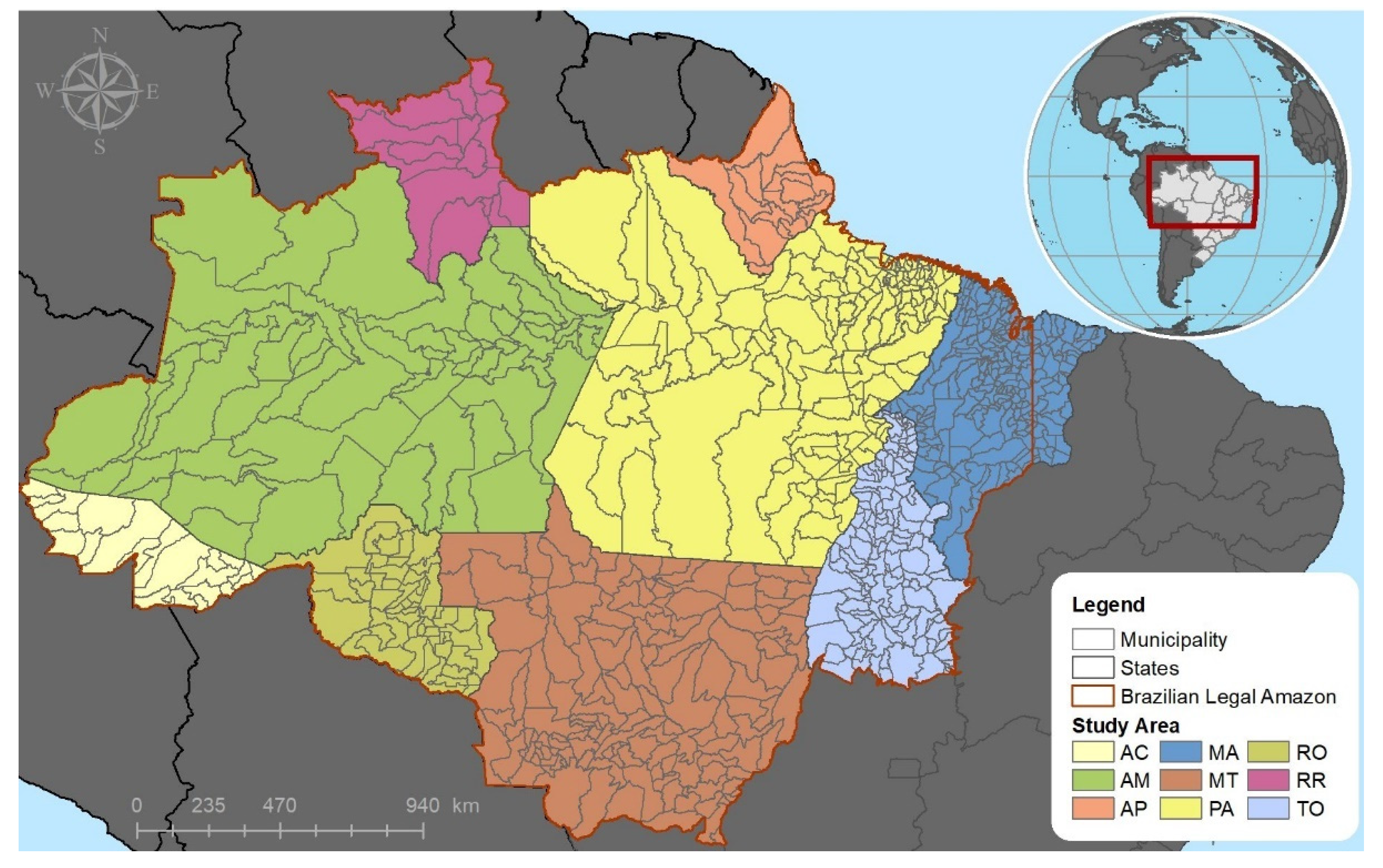
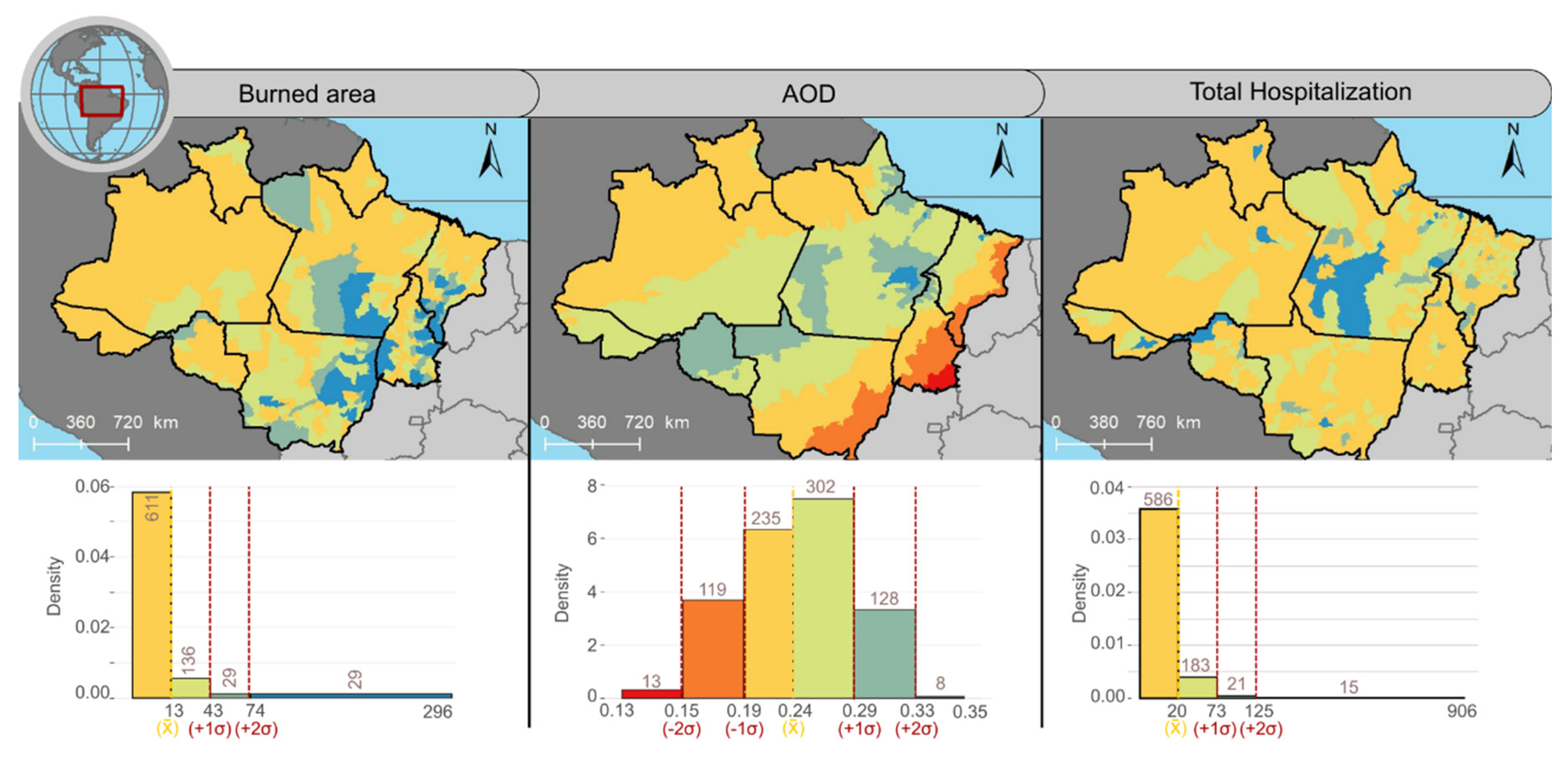
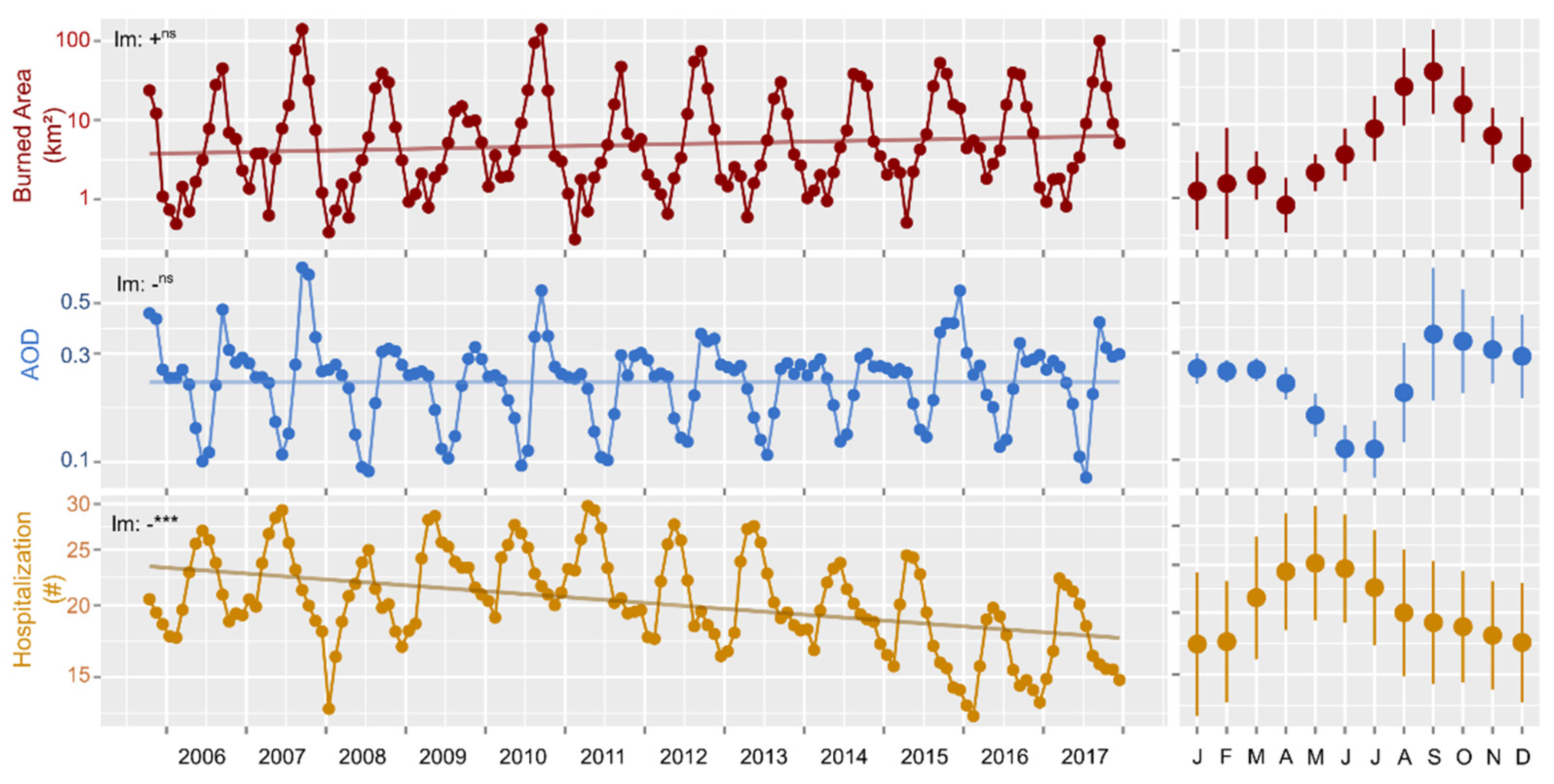
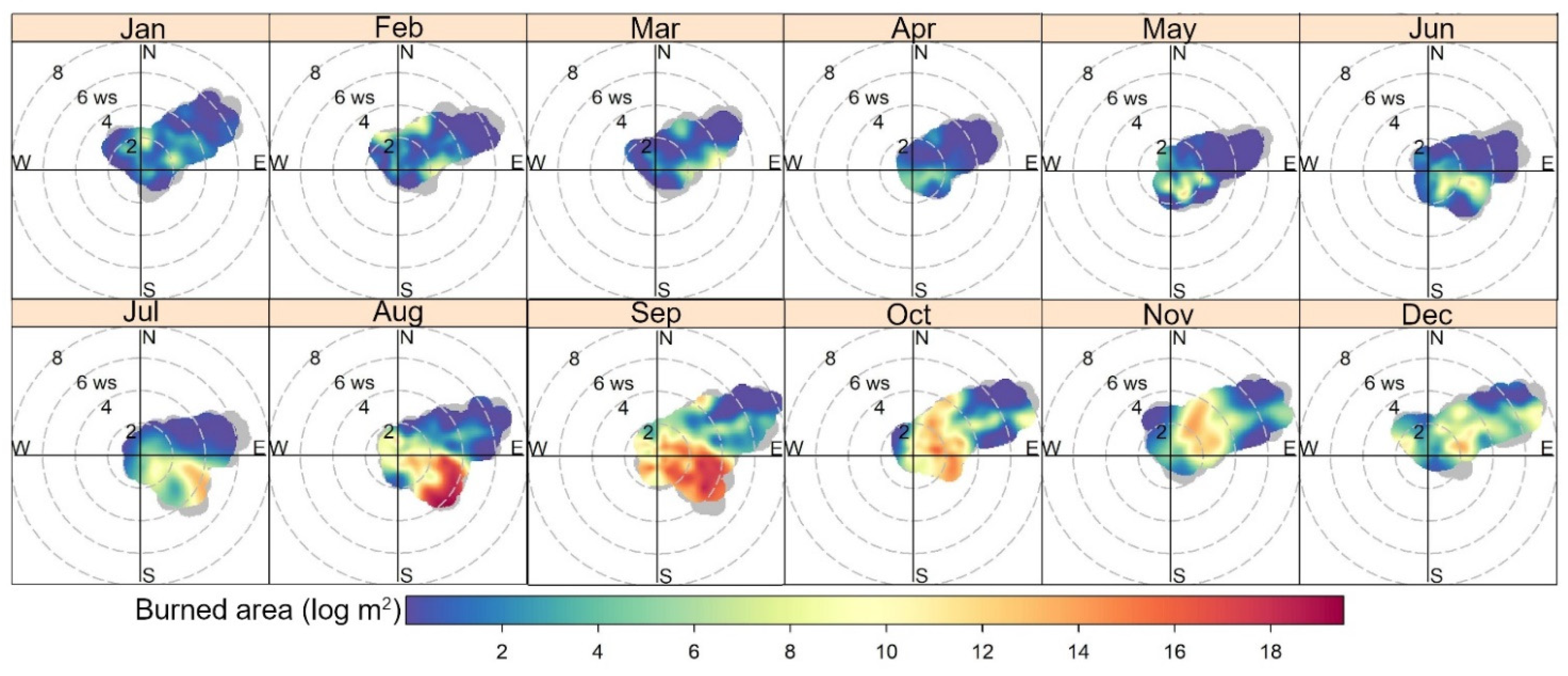


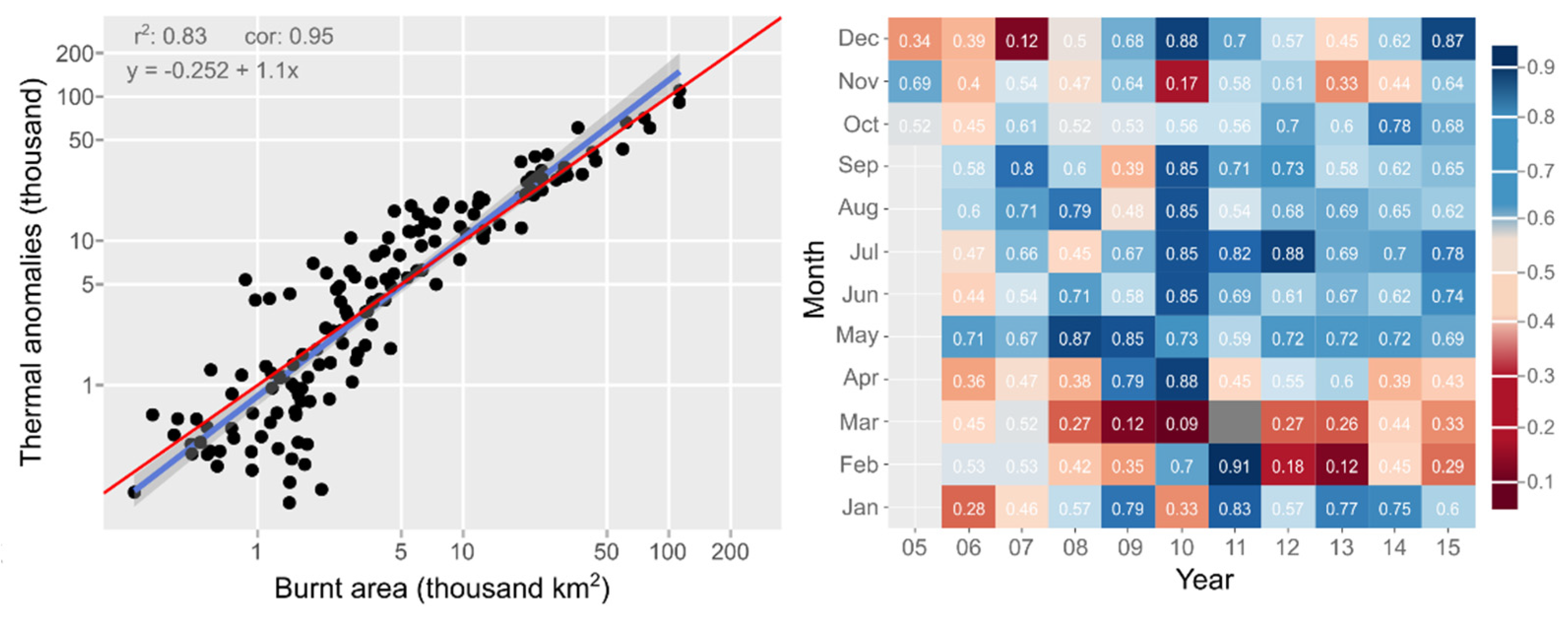
| Variable | Time | Spatial | Source | ||||||
|---|---|---|---|---|---|---|---|---|---|
| Tp. | Abr. | Description | Agg. | Period | Res. | Agg | Res. | Agg. | |
| IV | BA | Burned area | Sum | 2000–2020 | m | m | 500 m | mc | MCD64A1 |
| TA | Thermal anomalies * | Sum | 2003–2020 | m | m | 1 km | mc | MYD14A1 | |
| WDirec | Wind direction (degree) | Mean | 2001–2020 | m | m | 0.25° | mc | ERA5 | |
| WSpeed | Wind speed (m/s) | ||||||||
| ExpV | AOD | Land aerosol optical depth (AOD) | Mean | 2001–2020 | m | m | 1 km | mc | MCD19A2 |
| DpV | Hosp. | Hospitalization due to respiratory illnesses (ICD 10, Chapter X), by municipality of residence and age | Sum | 2001–2020 | m | m | - | mc | DataSUS |
| Asthma | Hospitalization due to asthma | Sum | 2001–2020 | m | m | - | mc | DataSUS | |
| Pneumonia | Hospitalization due to pneumonia | ||||||||
| Bronchitis | Hospitalization due to bronchitis | ||||||||
| CrV | Pop | Estimated population | Sum | 1992–2019 | y | y | - | uf | DataSUS |
| GDP | Gross domestic product in thousands of Brazilian Reais (BRL) | Sum | 2002–2017 | y | y | - | mc | IBGE | |
| Chd_d | Infant mortality | Sum | 01/2001–12/2018 | m | m | - | mc | DataSUS | |
| Crn_d | Chronic disease mortality (i.e., the total mortality due to respiratory, cardiovascular, diabetes, and neoplasm diseases) | Sum | 01/2001–12/2018 | ||||||
| Employe | Number of health professionals | Sum | 08/2005–12/2019 | ||||||
| Beds | Number of hospital beds | Sum | 10/2005–05/2020 | ||||||
| Faci. | Number of health facilities | Sum | 08/2005–05/2020 | ||||||
| Temp | Mean, minimum, and maximum temperature (Kelvin) | Min | 2001–2020 | m | m | 1 km | mc | MOD11A2 | |
| Mean | |||||||||
| Max | |||||||||
| Precp | Rainfall | Mean | 2001–2020 | m | m | 0.05° | mc | Chirps | |
| Road | Road density (m/m2) | 2019 | - | m | - | mc | OSM | ||
| Urb | Urban density (km2/km2) | Sum | 2001–2019 | y | y | 30 m | mc | MapBiomas | |
| Cars | Vehicle fleet | Sum | 2005–2019 | m | m | - | mc | Denatran | |
| Type | Variable | Unit | Mean | Std. Devia. | Min | Max |
|---|---|---|---|---|---|---|
| IV | BA | km2 | 13.1 | 87 | 0 | 5010 |
| TA | # | 14.25 | 73.06 | 0 | 6814 | |
| WDirec | degree | 1.39 | 1.02 | 0.002 | 7.72 | |
| WSpeed | m/s | 235.68 | 42.48 | 0.03 | 359.95 | |
| ExpV | AOD | - | 0.24 | 0.17 | 0.03 | 3.35 |
| DpV | Hosp. | # | 20.62 | 56.31 | 0 | 1676 |
| Small Children | # | 7.98 | 31.31 | 0 | 1215 | |
| Children | # | 2.54 | 7.60 | 0 | 232 | |
| Elders | # | 3.61 | 8.46 | 0 | 210 | |
| Asthma | # | 3.10 | 10.42 | 0 | 424 | |
| Pneumonia | # | 11.34 | 33.39 | 0 | 1092 | |
| Bronchitis | # | 0.73 | 5.42 | 0 | 264 | |
| CrV | Pop | # | 32,295 | 100,855 | 931 | 2,130,264 |
| GDP | mil R$ | 463,997 | 2,493,686 | 5606 | 73,200,000 | |
| Chd_d | # | 0.83 | 2.69 | 0 | 71 | |
| Crn_d | # | 0.53 | 2.34 | 0 | 72 | |
| Employe | # | 288 | 1159 | 0 | 28,166 | |
| Beds | # | 65 | 267 | 0 | 5099 | |
| Faci. | # | 24 | 91 | 0 | 1999 | |
| Temp_max | K | 309.7 | 4.7 | 299.0 | 353.9 | |
| Temp_med | K | 303.6 | 3.3 | 290.6 | 320.0 | |
| Temp_min | K | 297.3 | 6.0 | 247.7 | 314.8 | |
| Precp | mm | 5.24 | 4.46 | 0.00 | 29.05 | |
| Road | m/m2 | 4.65 | 14.41 | 0.01 | 242.00 | |
| Urb | % | 0.33 | 1.73 | 0.00 | 30.29 | |
| Cars | # | 6780.07 | 29,523.87 | 1.00 | 689,937 |
| LogBA | BaWSpeed | BaWDirec | |
|---|---|---|---|
| AOD | 0.0023 ns | −0.0672 *** | −0.0644 *** |
| Disease | Respiratory System | Asthma | Pneumonia | Bronchitis | |||
|---|---|---|---|---|---|---|---|
| Age | All | Small Children | Children | Elderly | All | All | All |
| Estimator | IV | IV | IV | OLS | IV | IV | OLS |
| IV set | IVc01 | IVc04 | IVC04 | - | IVc01 | IVc04 | - |
| Pollution coefficient | 0.1383 *** | −0.3381 *** | −0.1815 * | 0.00215 *** | 0.0792 *** | −0.1790 ns | 0.0103 ** |
| IV exogeneity and validity tests | |||||||
| Exog | 13.82 *** | 20.9530 *** | 7.6436 ** | - | 6.63 ** | 7.6513 ** | - |
| Overid | 1.20 ns | - | - | - | 3.56 ns | - | - |
| Weak instrument tests | |||||||
| Joint | 1103.36 | 252.589 | 252.589 | - | 1103.36 | 252.589 | - |
| Yogo: stat | 1445.95 | 282.652 | 282.652 | - | 1445.95 | 282.652 | - |
| Yogo: crit | 22.3 | 16.38 | 16.38 | - | 22.3 | 16.38 | - |
| Fixed effects | Y | Y | Y | Y | Y | Y | Y |
| Controls | Y | Y | Y | Y | Y | Y | Y |
| Obs. | 118,335 | 118,335 | 118,335 | 118,335 | 118,335 | 118,335 | 118,335 |
| Log_TA | TaWSpeed | TaWDirec | Log_BA | |
|---|---|---|---|---|
| AOD | 0.1672 *** | 0.0323 *** | 0.1002 *** | 0.6892 *** |
| Disease | Respiratory System | Asthma | Pneumonia | Bronchitis | ||||||||||
|---|---|---|---|---|---|---|---|---|---|---|---|---|---|---|
| Age | All | Small Children | Children | Elders | All | All | All | |||||||
| OLS | ||||||||||||||
| AOD | 0.0443 | *** | 0.0177 | ** | −0.0061 | ns | 0.0215 | *** | 0.0265 | *** | 0.059401 | *** | 0.0103 | ** |
| (0.0072) | (0.0067) | (0.0051) | (0.0051) | (0.0060) | (0.0069) | (0.0032) | ||||||||
| OLS sig. | 2925.84 | *** | 2114.69 | *** | 1139.8 | *** | 1460.89 | *** | 1040.86 | *** | 2391.69 | *** | 677.16 | *** |
| 2SLS | ||||||||||||||
| AOD | −0.0799 | * | −0.2493 | *** | −0.1250 | *** | −0.0405 | * | 0.0483 | ** | −0.1237 | *** | −0.0488 | ** |
| (0.0333) | (0.0349) | (0.0190) | (0.0176) | (0.0351) | (0.0155) | |||||||||
| 1S sig. | *** | *** | *** | *** | *** | *** | *** | |||||||
| 2S sig. | *** | *** | *** | *** | *** | *** | *** | |||||||
| Set of Instr. | 4 | 4 | 4 | 2 | 1 | 4 | 4 | |||||||
| Exogeneity and IV validity tests: | ||||||||||||||
| Exog. | 20.71 | *** | 128.64 | *** | 38.12 | *** | 14.79 | *** | 3.06 | . | 49.23 | *** | 22.67 | *** |
| Overid. | - | - | - | 0.4 | ns | 8.25 | * | - | - | |||||
| Weak Instrument tests: | ||||||||||||||
| Joint | 2876.23 | *** | 2876.23 | *** | 2876.23 | *** | 2177.03 | *** | 2482.61 | *** | 2876.23 | *** | 2876.23 | *** |
| Yogo: stat | 4782.32 | 4782.32 | 4782.32 | 3915.95 | 4311.03 | 4782.32 | 4782.32 | |||||||
| Yogo: crit | 16.38 | 16.38 | 16.38 | 19.93 | 22.30 | 16.38 | 16.38 | |||||||
Publisher’s Note: MDPI stays neutral with regard to jurisdictional claims in published maps and institutional affiliations. |
© 2021 by the authors. Licensee MDPI, Basel, Switzerland. This article is an open access article distributed under the terms and conditions of the Creative Commons Attribution (CC BY) license (https://creativecommons.org/licenses/by/4.0/).
Share and Cite
Campanharo, W.A.; Morello, T.; Christofoletti, M.A.M.; Anderson, L.O. Hospitalization Due to Fire-Induced Pollution in the Brazilian Legal Amazon from 2005 to 2018. Remote Sens. 2022, 14, 69. https://doi.org/10.3390/rs14010069
Campanharo WA, Morello T, Christofoletti MAM, Anderson LO. Hospitalization Due to Fire-Induced Pollution in the Brazilian Legal Amazon from 2005 to 2018. Remote Sensing. 2022; 14(1):69. https://doi.org/10.3390/rs14010069
Chicago/Turabian StyleCampanharo, Wesley Augusto, Thiago Morello, Maria A. M. Christofoletti, and Liana O. Anderson. 2022. "Hospitalization Due to Fire-Induced Pollution in the Brazilian Legal Amazon from 2005 to 2018" Remote Sensing 14, no. 1: 69. https://doi.org/10.3390/rs14010069
APA StyleCampanharo, W. A., Morello, T., Christofoletti, M. A. M., & Anderson, L. O. (2022). Hospitalization Due to Fire-Induced Pollution in the Brazilian Legal Amazon from 2005 to 2018. Remote Sensing, 14(1), 69. https://doi.org/10.3390/rs14010069








